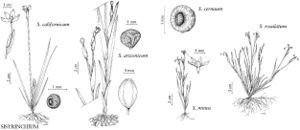Sisyrinchium rosulatum
Bull. Torrey Bot. Club 26: 228. 1899.
Herbs, annual or short-lived perennial, cespitose, yellowish green to medium or dark olive green when dry, to 3.6 dm, not glaucous. Stems branched or rarely simple, with 1–2 (–3) nodes, 0.7–2 mm wide, glabrous, margins usually entire, similar in color and texture to stem body; first internode 2–10 cm, usually shorter than leaves; distalmost node with 1–2 branches. Leaf-blades glabrous, bases not persistent in fibrous tufts. Inflorescences borne singly; spathes green, obviously wider than supporting branch, glabrous, keels usually entire; outer 13–32.2 mm, 2–8.2 mm longer than inner, tapering evenly towards apex or occasionally slightly constricted proximal to apex, margins basally connate 2.3–6.7 mm; inner with keel evenly curved to straight, hyaline margins 0.2–0.3 mm wide, apex acute, occasionally erose, ending 0.3–4.6 mm proximal to green apex. Flowers: perianth flaring distally, campanulate basally; tepals maroon or pink to lavender-rose with purple stripes, or yellow with rosy purple bases; outer tepals 5–11 mm, apex acute, rarely aristate; filaments connate basally, occasionally to 1/2 their length, basally inflated and stipitate-glandular 0.5–0.8 mm; ovary similar in color to foliage. Capsules tan with purplish sutures and sometimes apex, ± globose, 2.1–4.2 mm; pedicel spreading to recurved. Seeds ± globose, sometimes with slight depression, 0.5–1 mm, rugulose. 2n = 32.
Phenology: Flowering spring–fall.
Habitat: Roadsides, old fields, and other disturbed areas, stream banks, wet areas bordering woods
Elevation: 0–80 m
Distribution

Ala., Ark., Fla., Ga., La., Miss., N.C., S.C., Tex.
Discussion
Sisyrinchium rosulatum is apparently weedy throughout much of its range.
Selected References
None.
Lower Taxa
"/2" is not declared as a valid unit of measurement for this property."obviously wider" is not a number.
